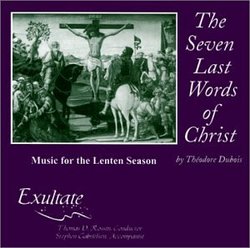| All Artists: Orchestra, soloists, Thomas D. Rossin, Theodore Dubois, Exultate Choir Title: The Seven Last Words of Christ (Music for the Lenten Season) Members Wishing: 0 Total Copies: 0 Release Date: 5/1/1999 Genre: Classical Style: Number of Discs: 1 SwapaCD Credits: 1 UPC: 659552105123 |
Search - Orchestra, soloists, Thomas D. Rossin :: The Seven Last Words of Christ (Music for the Lenten Season)
 | Orchestra, soloists, Thomas D. Rossin The Seven Last Words of Christ (Music for the Lenten Season) Genre: Classical
Théodore Dubois (1837-1924) was an important organist, composer and teacher of music on the Paris music scene during the 1860's. In 1861 he was awarded the prestigious Prix de Rome for composition. He studied at Reims... more » |
Larger Image |
CD Details
Synopsis
Album Description
Théodore Dubois (1837-1924) was an important organist, composer and teacher of music on the Paris music scene during the 1860's. In 1861 he was awarded the prestigious Prix de Rome for composition. He studied at Reims and the Paris Conservatory where he later was the director from 1896-1905. The composer of four operas, a large-scale ballet, several oratorios, a Requiem Mass as well as many orchestral works, Dubois remained a composer of the "academic style." Much overshadowed by his French contemporaries Charles Gounod, Gabriel Fauré and Camille Saint-Saëns in composition, he is best known for this book, Notes et Étues d'Harmonie (Notes and Lessons in Harmony), still a source for harmonic practice in the Romantic style. He succeeded Saint-Saëns as organist at the Madelaine in 1877 and was highly regarded as an excellent music teacher. The oratorio The Seven Last Words of Christ was first performed at Saint Clotilde in Paris in 1867 where Dubois was the choir director. Scored originally for full orchestra, chorus and soloists, Dubois later revised his orchestration to include only organ, timpani and harp, the version most often heard. This performance uses the original orchestration of 2 flues, 2 oboes, 2 clarinets, 2 bassoons, 2 horns, 3 trombones, strings, organ and percussion. The work is presented in eight movements: an introduction for soprano and orchestra followed by a movement for each word of Christ from the cross. The last movement ends with a hymnic prayer set in homophonic style much like a choral at the end of a cantata from the 18th century. - TDR

 Track Listings (11) - Disc #1
Track Listings (11) - Disc #1